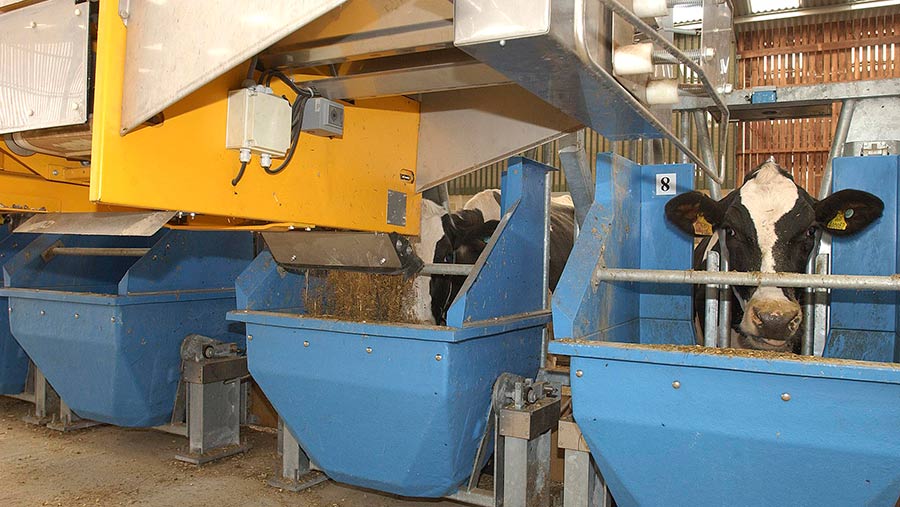New trial offers a cost-effective alternative to soya in dairy cow diets

Wheat distillers grain presents a viable and cost-effective protein alternative to soya bean meal in dairy cow diets, a four-year UK study has concluded.
Professor Phil Garnsworthy, head of animal science at the University of Nottingham, led the £2.6m environment and nutritional benefits of bioethanol co-products (ENBBIO) project.
It sought to determine the nutritional value of wheat distillers and the quantity that could be included in rations to maintain performance compared to more traditional diets containing soya.
Initial animal trials found that the metabolisable energy (ME) of British wheat distillers meal was 13.4MJ/kg of dry matter.
This was midway between that of barley and wheat, but 11% higher than rapeseed meal with marginally higher rumen bypass protein than rapeseed meal albeit similar crude protein (see table one).
Table 1: Typical British wheat distiller analysis
| Dry matter | 89% |
| ME (MJ/kg DM) | 13.4 |
| Protein | 32% |
| Oil | 6.5% |
| NDF | 29% |
| Starch | 2% |
| Sugars | 3% |
| DUP (Bypass protein) | 10.5% |
With this knowledge, a large-scale dairy study was carried out using high-yielding early to mid-lactation cows (>11,500 litres).
Soya bean was incrementally replaced in their diets with wheat distillers until 22% of the total day matter was substituted (see table 2).
All rations were balanced with similar energy, metabolisable protein and minerals, but not for starch as wheat was also reduced to balance the protein.
“Many advisers and producers would be concerned that diminishing starch would reduce yield and or milk protein,” said Dr Michael Marsden, technical manager at Trident Feeds, who worked closely with Professor Garnsworthy on the studies.
“This wasn’t the case at all; as milk yields and compositions were not significantly different, irrespective of the amount of wheat distillers, milk fat and protein percent that were marginally higher or identical when wheat distillers were fed compared with the control non-wheat distillers fed cows.”
“I believe we saw similar performance to soya-rich diets due to a mix of the energy being as digestible fibre, not starch, thus reducing the risk of rumen pH reductions, and consequently lower rumen microbe activity, combined with the high yeast debris content from the bioethanol fermentation having a stimulatory effect on the rumen microbes,” he says.
Table 2: Wheat distillers as percentage of total dry matter intake
| Wheat distillers as percent of total dry matter intake | 0% | 7.5% | 15% | 22.5% | Difference |
| Dry matter intake (kg/day) | 22.9 | 22.5 | 22.2 | 22.1 | Not significant |
| Energy corrected yield (litres/day) | 32.3 | 32.8 | 32.1 | 31.7 | Not significant |
| Fat % | 3.91 | 4.08 | 4.08 | 4.01 | Not significant |
| Protein % | 3.51 | 3.55 | 3.51 | 3.50 | Not significant |
“Results of this study provide further support for the conclusion that wheat distillers can be included in diets for dairy cows at up to 20% of dry matter intake without detrimental effect on cow performance or health,” Professor Garnsworthy explains.
This, he says, was consistent with other studies on wheat distillers, and parallel studies with maize distillers replacing maize corn and soya.
Cost savings
Producers also stand to save money by included wheat distillers in dairy cow diets, says Dr Marsden.
Where the cost of 55% soya and 45% wheat is greater than that of wheat distillers, producers could see savings of up to 15p a cow a day, he says.
And with the energy content 11% higher than rapeseed meal, it is worth a premium over rape meal, he adds.
“The aim of the project was to investigate how domestic wheat distillers could compete with the protein market in Europe where approximately 27m tonnes of imported soya bean meal is used every year,” explains Dr Marsden.
“Soya is imported from outside the EU and with the world demanding more meat and milk products, our protein sources could be under threat and we shouldn’t be lulled into a false sense of security of ongoing low soya prices following two years of good world harvests,” warns Dr Marsden.
Table 3: Partial mixed ration formulations containing varying levels of distilled dried grains with solubles (DDGS)
| DDGS % | 0% | 7.5% | 15% | 22.5% |
| Grass silage | 16.0 | 16.0 | 16.0 | 16.0 |
| Maize silage | 11.0 | 11.0 | 11.0 | 11.0 |
| Whole crop silage | 9.0 | 9.0 | 9.0 | 9.0 |
| Chopped straw | 0.5 | 0.5 | 0.5 | 0.5 |
| DDGS | 0 | 2.0 | 4.0 | 6.0 |
| Sugar beet pulp | 1.0 | 0.67 | 0.33 | 0 |
| Soya bean meal | 2.0 | 1.33 | 0.67 | 0 |
| Rapeseed meal | 2.75 | 1.83 | 0.92 | 0 |
| Wheat-rolled | 2.5 | 2.0 | 1.5 | 1.0 |
| Fat supplement | 0.25 | 0.25 | 0.25 | 0.25 |
| SoyPass | 0 | 0.27 | 0.53 | 0.80 |
| Mineral and vitamin mix | 0.15 | 0.15 | 0.15 | 0.15 |
| Sodium bicarbonate | 0.1 | 0.1 | 0.1 | 0.1 |
| Limestone flour | 0.125 | 0.125 | 0.125 | 0.125 |
| Urea | 0.08 | 0.053 | 0.027 | 0 |
| TOTAL | 45.5 | 45.3 | 45.1 | 44.9 |
*Values are kg of fresh weight per cow per day
